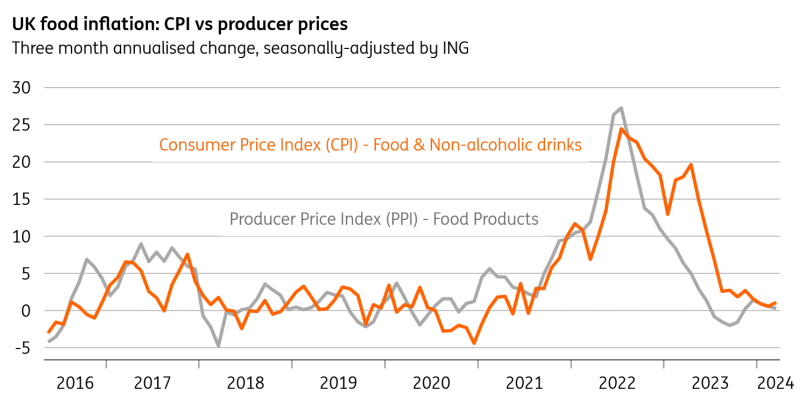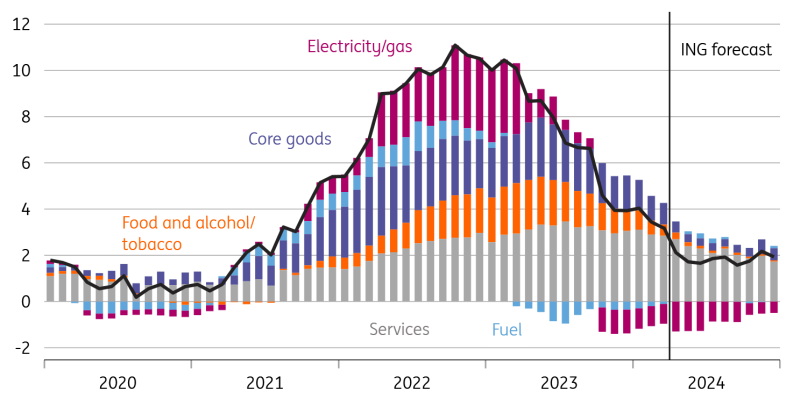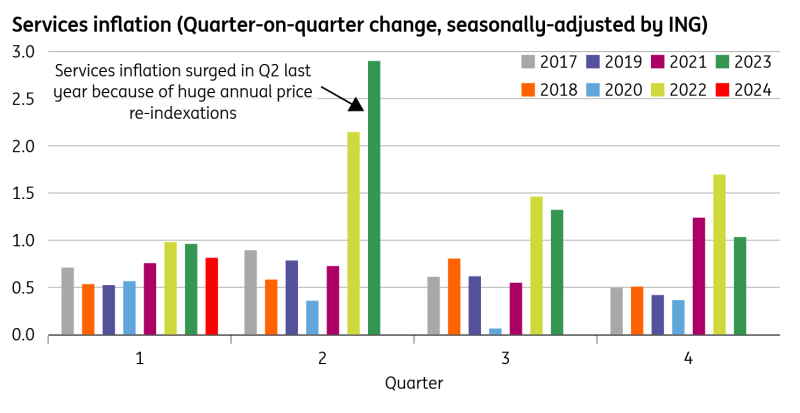Headline inflation is virtually back to target
It’s no exaggeration to say that this week’s UK inflation data will make or break a June rate cut from the Bank of England. Markets are pricing a 58% chance of that happening, at the time of writing.
Certainly at a headline level, the story should be a good one. Overall inflation, previously 3.2%, is likely to fall to within a whisker of the Bank’s 2% target. Some of this can be traced back to the 12% fall in household electricity/gas bills that we saw at the start of April. And we’re likely to see something similar again in July.
That’s when Ofgem – the UK’s energy regulator – next updates the household price cap, and wholesale natural gas prices were lower during the so-called ‘observation window’ than they were when April’s cap was calculated. The result is that electricity/gas will be subtracting roughly one percentage point or more from headline inflation during the second and third quarters.
Household energy bills set to fall again in July

Utilities are only part of the story though. Food price inflation is slowing very rapidly, and having peaked close to 20% this time last year, we think it’ll be near enough zero over the summer. Producer price inflation – a gauge of what the supermarkets are effectively paying – has been flat or slightly negative for several months now, and that’s very clearly feeding through to consumers. Take a look at this chart of the three-month annualised change in consumer and producer food prices below.
Food price inflation has slowed right down

There’s also some further disinflation in ‘core goods’ too – that’s anything unrelated to energy. We’ve already seen a lot of progress here, with both household goods and vehicles in deflation now. This is a legacy of improved supply chains, higher inventory levels and lower consumer demand last year. While the latter is starting to improve, we think there’s still some further limited disinflation to come in this area of the inflation basket.
The result is that headline inflation will, we think, dip below the Bank of England’s 2% target in May’s data due in June and stay there for most – if not all – of this year. Interestingly, the BoE itself expects headline CPI to end the year closer to 3%.
Headline inflation to dip below target in May

Services inflation is a major uncertainty this week
If we’re right, then that should be a recipe for several rate cuts this year. We expect at least three, which is slightly more than markets are pricing.
But in the very short term, there’s still some uncertainty over services inflation. That’s ultimately what the BoE is most interested in, and it seems to have assumed even greater prominence in the monetary policy decision-making process given recent volatility in the wage figures.
Again the story here is improving, but crucially we think the risk to this week’s services CPI figure is to the upside. April is a time where several price categories see annual price resets, often linked explicitly to prior rates of headline inflation. Just think of phone or internet bills, for example. Social rents are another key area to watch.
On paper, this process should therefore be fairly predictable. We know that the recent headline inflation rates underpinning these price rises are considerably lower than they were last April.
But last year showed how unpredictable this process can be. Services inflation came in significantly higher than everyone – the BoE included – had expected, triggering the biggest single daily move in UK swap rates for the whole of 2023. The figure in 2022 was also pretty high.
2022 and 2023 saw big April price spikes in services

The Bank of England expects services inflation to dip from 6.0% to 5.5% in April’s data due this week. Consensus expects 5.4%, and we expect 5.6%. Slight deviations here or there are not likely to substantially move the needle for the Bank. And it's worth saying we do get another inflation release just ahead of June’s meeting, but we think there’s less uncertainty surrounding that set of data.
Policymakers have indicated that the data needs only come in roughly in line with forecasts to justify a near-term cut; it doesn’t require a material undershoot. BoE Governor Andrew Bailey, who was noticeably dovish in his recent press conference, doesn’t appear to need much more evidence to be comfortable with cutting rates.
The bottom line is that if the data comes in with expectations, a June rate cut would quickly become the base case. But given the committee is visibly divided, a bigger upside surprise to services inflation this week would move the dial back towards August for the first rate cut. That’s been our long-held base case, and we'll review that after this week's data.
